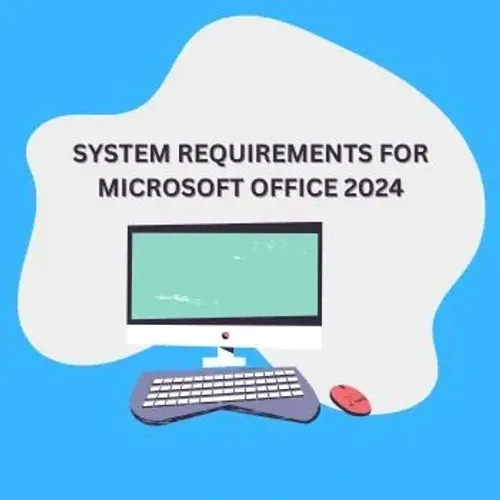Understanding the System Requirements for Microsoft Office 2024

As we eagerly await the release of Microsoft Office 2024, it’s crucial to prepare our systems for optimal performance. Whether you’re an individual user or part of an organization, knowing the system requirements for installing Office 2024 is essential to ensure a smooth installation and seamless operation. In this blog, we’ll break down the expected system requirements, provide tips for upgrading your hardware if necessary, and discuss how these requirements may influence your decision to upgrade.
General System Requirements
While Microsoft has yet to officially confirm the final specifications for Office 2024, we can anticipate that the system requirements will be similar to those of previous Office versions, with some enhancements to accommodate new features and functionalities. Here are the expected minimum requirements for installing Office 2024:
Operating System
Windows: Microsoft Office 2024 will likely require Windows 10 (version 1909 or later) or Windows 11. Users of older Windows versions may find themselves unable to install or run Office 2024 effectively.
Mac: On the macOS side, expect compatibility with the latest versions, likely macOS Monterey (12) and Ventura (13). Older versions may not support the new features or security enhancements.
Processor
Windows: A 1.6 GHz or faster, dual-core processor is expected as the minimum requirement. However, for better performance, especially with multitasking and heavier applications like Excel and PowerPoint, a faster processor is recommended.
Mac: A multi-core Intel processor or Apple Silicon (M1 or later) will likely be required to ensure smooth operation, particularly for graphics-intensive tasks.
RAM
Windows: Office 2024 is expected to require at least 4 GB of RAM, although 8 GB or more will be ideal for multitasking and working with large documents or datasets.
Mac: Similarly, a minimum of 4 GB of RAM is expected, with 8 GB recommended for optimal performance, especially for users who tend to run multiple applications simultaneously.
Storage Space
Windows: Users will likely need at least 4 GB of available disk space for installation, with additional space required for updates and personal files. It’s a good practice to have at least 10 GB of free space to ensure smooth operation.
Mac: Expect similar storage requirements of around 4 GB for installation, plus additional space for updates, documents, and other applications.
Display
Windows: A display with at least a resolution of 1280 x 768 pixels is anticipated. Higher resolutions (1920 x 1080 or higher) will enhance the user experience, especially for design and content creation tasks.
Mac: A Retina display with 1280 x 800 resolution or higher is recommended to take full advantage of Office 2024’s visual features and clarity.
Internet Connection
An active internet connection will likely be required for product activation, updates, and some features that rely on online services, such as collaboration tools in Word and Excel. A stable broadband connection will enhance your experience, particularly when working with cloud-based features in Microsoft 365.
Additional Considerations
Compatibility with Older Versions
If you are currently using an older version of Office, such as Office 2019 or Office 2016, it’s important to consider how your existing hardware will handle the new software. While Office 2024 is expected to be more resource-intensive due to new features and improvements, most modern systems that meet the minimum requirements should be able to run it efficiently. However, older hardware may struggle, especially with demanding tasks.
Upgrading Your Hardware
If your current setup doesn’t meet the anticipated requirements for Office 2024, consider these options:
Increase RAM: Upgrading your RAM is one of the most cost-effective ways to improve performance, particularly for multitasking and running memory-intensive applications.
Upgrade Your Processor: If your system allows for it, upgrading to a faster processor can significantly enhance performance, especially for tasks that require intensive computation.
Add SSD Storage: If you’re using an older hard drive, consider switching to a solid-state drive (SSD). SSDs offer faster read and write speeds, improving overall system responsiveness and reducing load times for applications.
Ensure Graphics Capability: If you work extensively with graphics or video content, having a dedicated graphics card can greatly enhance performance in applications like PowerPoint and Publisher.
Impact on Decision-Making
Understanding these system requirements can significantly impact your decision to upgrade. If your current hardware is on the lower end of the requirements, you might weigh the benefits of upgrading your hardware against the features you’ll gain with Office 2024. It’s essential to evaluate how Office 2024 aligns with your productivity needs and whether the investment in new hardware is justified.
Conclusion
As we approach the release of Microsoft Office 2024, being informed about the expected system requirements is key to ensuring a seamless transition. By understanding the necessary hardware and software specifications, you can prepare your system for optimal performance, allowing you to take full advantage of the new features and enhancements that Office 2024 will bring.
Whether you’re a casual user, a student, or a business professional, ensuring that your system meets these requirements will allow you to work efficiently and effectively. As always, keeping your system updated and considering future-proofing your setup can pay off in the long run, making your productivity tools work for you, not against you. Stay tuned for more updates and make sure your systems are ready to embrace the next generation of Microsoft Office!

